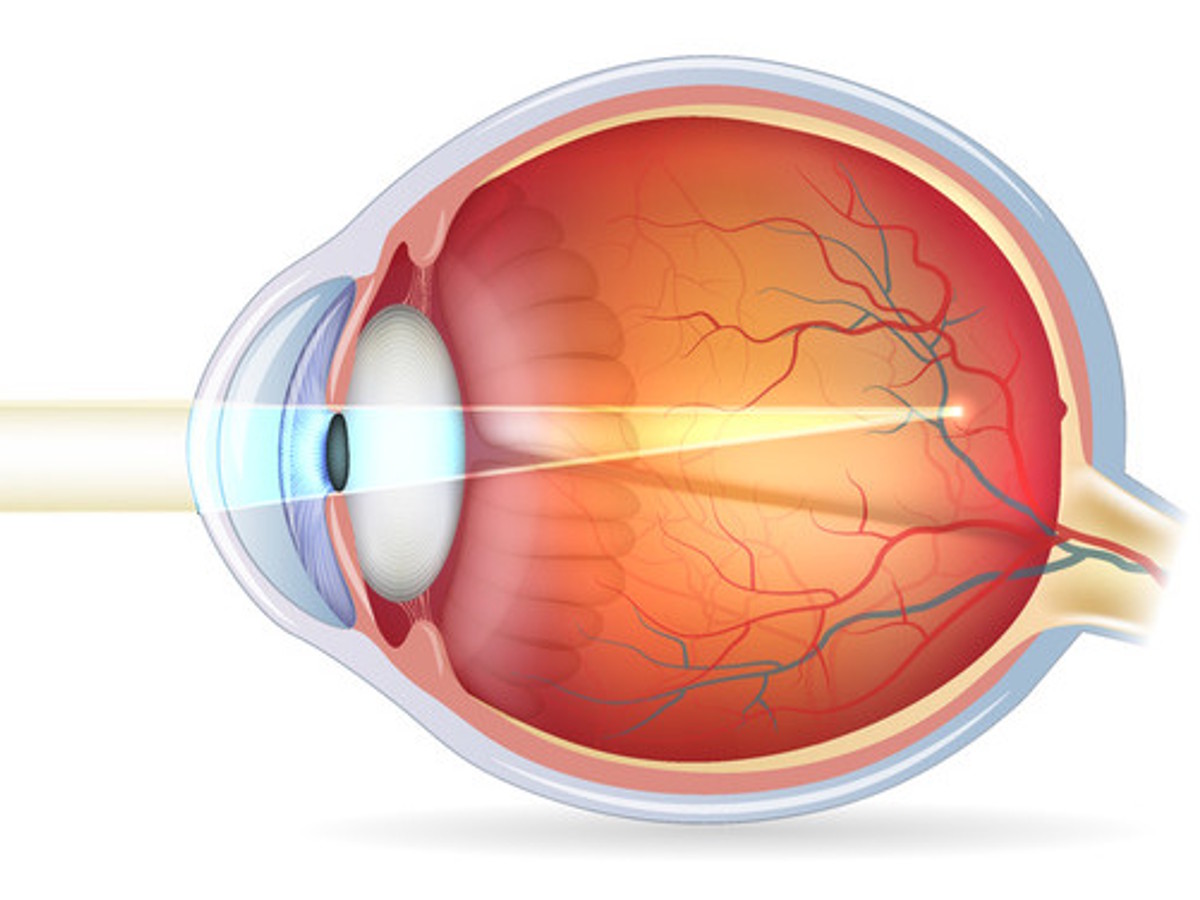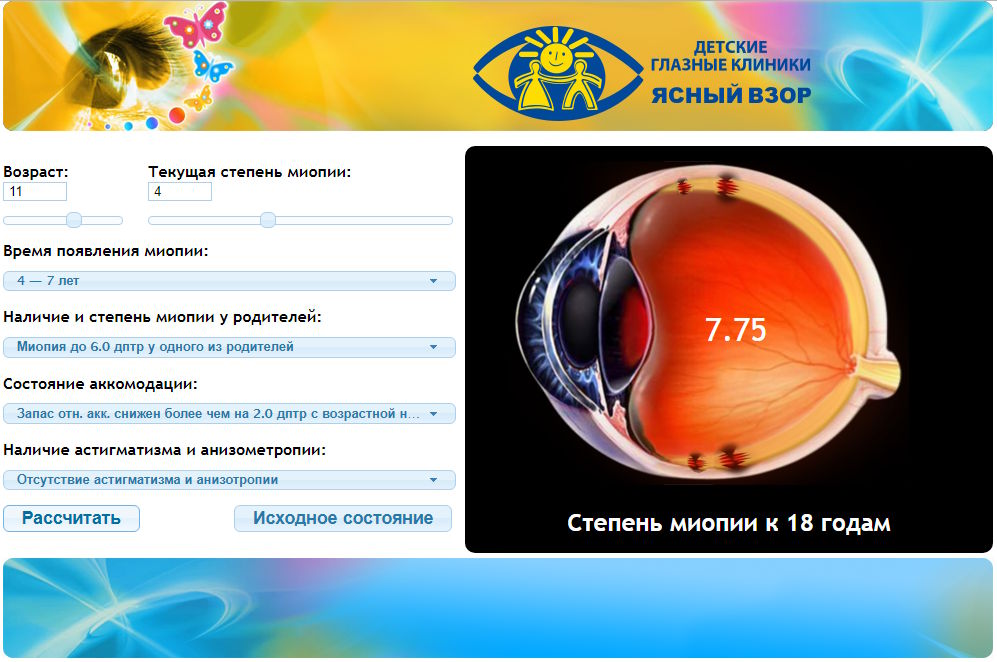According to Rosstat, about 1.5 million children under 14 years of age are initially diagnosed with vision problems every year. 30% of children in Russia today graduate from school with myopia.

The main factors that affect the decrease in visual acuity: heredity, uncontrolled interest in gadgets, early education of children, i.e. long-lasting drawing or reading at close distance, poor lighting, an incorrect daily regimen of the child, a short period of staying in the fresh air, and large visual loads during school.
Myopia in children is more than only an optical defect that can be easily corrected with glasses. When the eyeball is elongated, the intraocular structures stretch, especially the retina. As a result, dystrophic changes occur in the fundus, which, in the case of progression, may lead to an irrevocable decrease in vision.
We have developed a program that allows calculating the degree of myopia that a child will have if proper and timely treatment is not carried out.

We have developed programs for effective therapeutic treatment of myopia in children, which allow stabilizing myopia in 85% of cases and in other cases, significantly slow down the rate of its progression and achieve a sustainable result.
The treatment includes a complex of functional and medicinal procedures.
The most effective treatment of myopia today is hardware-based. But it is important to understand that children's myopia has its own specifics; its cause of emergence and progression. In this case, there cannot be a single device that helps everyone from all diseases!
We, at Yasniy Vzor, have a different, an integrated approach in the treatment of myopia in children. In the case of myopia, treatment should be aimed at its stabilization.
Our specialists develop a treatment program for myopia in children after a comprehensive examination of a child with myopia, which allows us to identify the causes and the mechanism of its progression, as well as the presence of possible complications, i.e. dystrophic changes in the fundus and retina. Our program of treatment of children's myopia includes various procedures of physical, optical, and medical effects. The mode and combination are always determined individually. The achievements of world pediatric ophthalmology have proven the effectiveness of small doses of medications that relax the tension of the intraocular muscles. These medications are prescribed individually as well; the concentration and dose of the medication are selected taking into account the specifics of the patient.
In some cases, a complex of therapeutic measures is carried out against the background of the assigning of so-called "night" lenses.
The treatment is always under the control of an encephalogram, which allows avoiding possible complications and, if necessary, cancel certain methods. Unfortunately, this practice is not available in district clinics, in the department of vision protection. Therefore, we have repeatedly admitted patients who have complications related to the lability of the nervous system, received as a result of previous unqualified treatment.
Scleroplasty, which is widely used in our country, does not affect the stabilization of myopia. After the first postoperative year, myopia starts to progress again. We, like our foreign colleagues, refused to perform scleroplasty due to the lack of reliable effect of this intervention. For this reason, we do not recommend performing scleroplasty for children.
The earlier treatment of progressive myopia is started, the more opportunities are obtained to prevent the development of complications in the fundus. In the case of no treatment, it is almost impossible to predict the course of the disease, which may lead to the rapid growth of myopia and eye damage. If the child is under supervision, such sudden changes can be avoided. During the treatment of myopia, the allowed growth is no more than 0.5 D per year. With this growth gradient, the child's fundus is not affected.
The mechanism of the development of myopia in children has been sufficiently studied. This disease is associated with a pathological elongation of the eyeball. This elongation is caused, on the one hand, by an inherited predisposition, and on the other hand, by excessive loads on the insufficiently complete focusing apparatus of the eyeball. Such elongation leads to stretching of intraocular structures and their irreversible changes. That is why myopia greater than 2 diopters (which is an additional lengthening of the eye by as less as 0.66 mm) may pose a threat of serious complications. This understanding is the basis for all measures for the diagnosis and treatment of myopia, which are used at our Yasniy Vzor children's eye clinics..
For children with myopia, as well as in the absence of any eye pathology, visual hygiene is of great importance. The child's visual load should be dosed. Reading is only possible while sitting at a table under good lights. Reading while lying down and eating is not recommended. The length of time of watching TV programs is very important. Children under two years of age are not recommended to watch TV at all. This is due both to eye loads and to the effect on the central nervous system, which may lead to excitation of the child. However, we cannot completely exclude TV from our children's lives. The following is advisable. For children under 7 years of age, the total duration of watching television programs should not exceed 30-40 minutes per day. At an older age, children are allowed to watch TV for up to 1.5-3 hours a day. In this case, the continuous load should not exceed 1.5 hours (one movie).
The type of TV (regular, "flat" screen, liquid crystal panel, plasma TV) practically does not affect the tolerance of visual loads. When watching TV, the main harmful factor is a long-lasting visual load at a finite distance.
The same can be said about working on a computer. The duration of working at the computer should also be limited to 40 minutes per day. Due to the elongation of the eyeball, the image on the retina becomes unfocused and the child complains of a decrease in distant vision. To see distant objects, children often squint because the compressed eyelids play in this case the role of a diaphragm and the image on the retina becomes clearer.